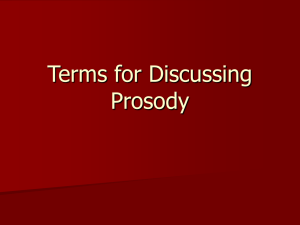shakespearean sonnet
advertisement
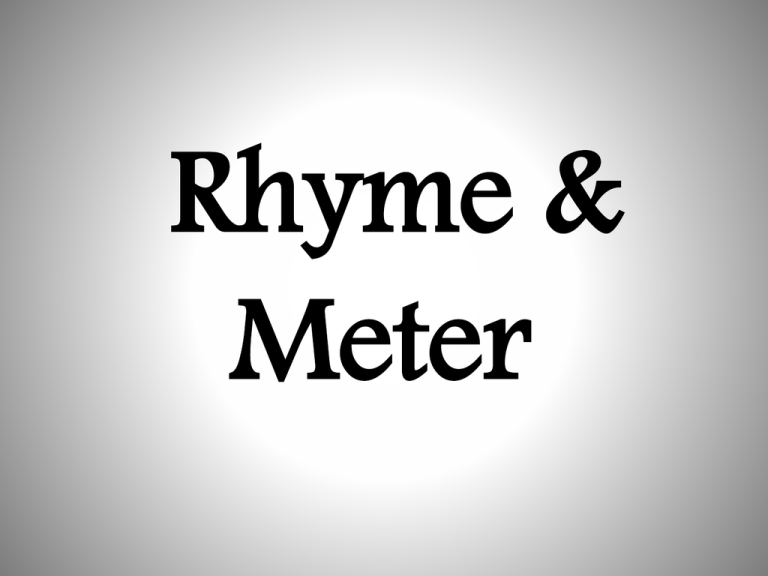
Rhyme & Meter Review 1. How many syllables does “dilemma” have? 2. How many syllables do iambs & trochaics have? 3. The word “infer” has what type of rhythm? 4. How many syllables do anapestic & dactylic have? 5. The word “happily” has what type of rhythm? 6. The beat of poetry (stressed & unstressed) is called? 7. The length of a line of poetry based on rhythm is called? 8. Meter is measured in units of 2 or 3 syllables called…? 9. If a line of poetry has 1 foot it is called? 10. If a line of poetry has 4 feet it is called? More Rhyme & Meter Shakespearean sonnets • Contains 3 quatrains and a heroic couplet, all written in iambic pentameter. • 14 lines long • Rhyming pattern of the sonnets: – abab, cdcd, efef, gg • Iambic Pentameter: a meter of syllables (unstressed, stressed) containing 5 feet. • Heroic Couplet: last two lines of the sonnet that has 2 rhyming lines. My mistress' eyes are nothing like the sun; A Coral is far more red than her lips' red; B If snow be white, why then her breasts are dun; A If hairs be wires, black wires grow on her head. B I have seen roses damasked, red and white, C But no such roses see I in her cheeks; D And in some perfumes is there more delight C Than in the breath that from my mistress reeks. D I love to hear her speak, yet well I know E That music hath a far more pleasing sound; F I grant I never saw a goddess go; E My mistress when she walks treads on the ground. F And yet, by heaven, I think my love as rare G As any she belied with false compare. G Meter/feet • The rhythm of a poem is expressed in feet or syllables. The syllables are either stressed or unstressed. The pair (2) of syllables become a foot. • In iambic pentameter there are 5 feet (10 syllables) • The syllables are unstressed ( ) or stressed ( / ) • The division of the feet is marked by the symbol ( ǀ ) • It sounds like: ᵕ / / / / / ᵕ ᵕ ᵕ ᵕ ᵕ da DUM ǀ da DUM ǀ da DUM ǀ da DUM ǀ da DUM ǀ My mistress' eyes are nothing like the sun; A Coral is far more red than her lips' red; B If snow be white, why then her breasts are dun; A If hairs be wires, black wires grow on her head. B I have seen roses damasked, red and white, C But no such roses see I in her cheeks; D And in some perfumes is there more delight C Than in the breath that from my mistress reeks. D I love to hear her speak, yet well I know E That music hath a far more pleasing sound; F I grant I never saw a goddess go; E My mistress when she walks treads on the ground. F And yet, by heaven, I think my love as rare G As any she belied with false compare. G iambic iambic foot iambic pentameter pentameter rhyming pattern heroic couplet quatrain Shakespearean sonnet 1. A __________ consists of 4 lines of verse in a poem. 2. __________ refers to the foot that is used in a rhyming pattern. 3. __________ = five 4. A pair of syllables containing unstressed/stressed syllables is an __________ . 5. Poems written in iambic pentameter are typically referred to as __________. 6. Typical of Shakespearean Sonnets, the last two lines are referred to as the __________ . 7. In a Shakespearean Sonnet the __________ is abab, cdcd, efef, gg 8. A meter used in poetry consisting of 5 feet in a line, or ten syllables is written in __________ . MORE POETRY CONCEPTS & TERMS Eye Rhymes • When words look like thy should rhyme but in actuality do not. • Example: Stone & none Dove & move Bough & though • You can pronounce them so they rhyme even though they don’t in reality. • Open your books to page 162 “Upon his Departure Hence” Parallelism • Parallelism is the construction of 2 or more thoughts in the same pattern. 3 types of parallelism: 1. An idea is stated in the first line & restated in the 2nd For he hath founded it upon the seas, And established it upon the floods. 2. An idea is stated in the first line & contrasted in the 2nd Trust in the LORD with all your heart; And lean not unto your own understanding. 3. A thought is developed/expanded throughout the poem The law of the LORD is perfect, converting the soul: The testimony of the LORD is sure, making the wise simple. The statutes of the LORD are right, rejoicing the heart: The commandment of the LORD is pure, enlightening the eyes. Psalms in the Bible • The Psalms were songs and poems originally written in Hebrew and had their own sound and style • Isaac Watts translated the Psalms of the Bible into English verse, giving them rhyme and meter. • He wrote most of the Psalms using the 3 most popular meters: – Common meter (a quatrain with a syllable pattern of 8686) – Short meter (a quatrain with a syllable pattern of 6686) – Long meter (a quatrain with a syllable pattern of 8888) Psalms Turn to page 166

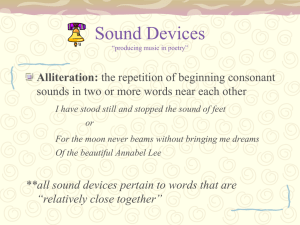
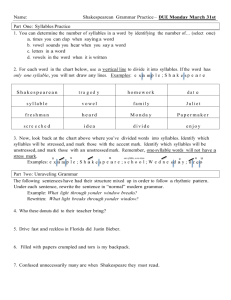
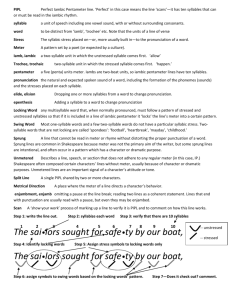
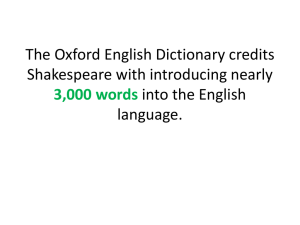
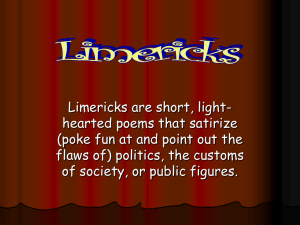
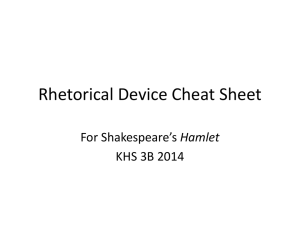

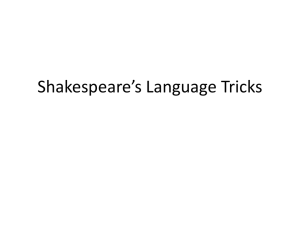
![iambic-pentameter-powerpoint[1]](http://s2.studylib.net/store/data/005389283_1-88464eb62969318d407043f4e7784268-300x300.png)

